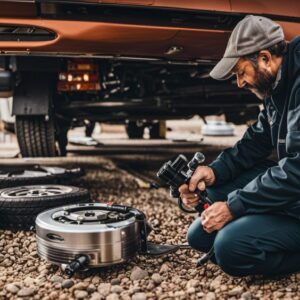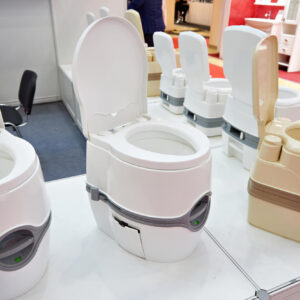Motorhomes are a popular choice for those who love to travel and explore the great outdoors. However, like any vehicle, they can experience starting problems that can be frustrating and time-consuming to diagnose and fix. Fortunately, many of these issues can be easily resolved with a little knowledge and troubleshooting.
One of the most common reasons why your motorhome won’t start is due to a dead or weak battery. A battery that is not charged or is failing to hold a charge can cause issues with starting the engine. If you turn the key and only hear a clicking sound, this is usually a sign of a dead battery. Additionally, a faulty starter motor or ignition switch can also prevent your motorhome from starting. Understanding these common issues and how to diagnose them can save you time and money in the long run.
Understanding Motorhome Starting Problems
Starting problems in a motorhome can be frustrating and stressful, especially when you’re on the road and need to get going. There are several reasons why your motorhome may not start, and understanding them can help you diagnose and fix the problem quickly.
One of the most common reasons for a motorhome not starting is a dead or weak battery. A battery that is not charged or is failing to hold a charge can cause issues with starting the engine. If you turn the key and only hear a clicking sound, this is usually a sign of a dead battery. To avoid this problem, it’s important to keep your battery charged and replace it when necessary.
Another possible cause of starting problems is a faulty starter motor. The starter motor is responsible for turning the engine over when you turn the key, and if it’s not working correctly, the engine won’t start. Signs of a faulty starter motor include a grinding noise when you turn the key, or the engine turning over slowly or not at all. In this case, you may need to have the starter motor replaced.
If your motorhome is not starting, it could also be due to a problem with the ignition switch. The ignition switch is responsible for sending power to the starter motor when you turn the key, and if it’s not working correctly, the engine won’t start. Signs of a faulty ignition switch include no power to the starter motor when you turn the key, or the engine turning over but not starting. In this case, you may need to have the ignition switch replaced.
Other possible causes of starting problems in a motorhome include a clogged fuel filter, a faulty fuel pump, or a problem with the engine’s sensors or computer. If you’re experiencing starting problems, it’s important to have your motorhome diagnosed by a qualified mechanic to determine the root cause of the problem.
In summary, starting problems in a motorhome can be caused by a variety of factors, including a dead battery, a faulty starter motor, a faulty ignition switch, or other issues with the fuel system or engine. If you’re experiencing starting problems, it’s important to have your motorhome diagnosed by a qualified mechanic to determine the root cause of the problem and get it fixed as soon as possible.
Key Components and Their Role
When it comes to starting problems in your motorhome, there are several key components that you need to check. Here are some of the most important components and their roles:
Battery and Connections
The battery is the heart of your motorhome’s electrical system. It provides power to the starter motor and the ignition system. If your battery is dead, your motorhome won’t start. Check the battery terminals and connections to make sure they are clean and tight. If you have a multimeter, you can test the battery voltage to see if it is fully charged.
Ignition Switch and Starter Motor
The ignition switch is responsible for sending power to the starter motor when you turn the key. If the ignition switch is faulty, your motorhome won’t start. The starter motor is responsible for turning the engine over. If the starter motor is faulty, your engine won’t start. Check the connections to the ignition switch and the starter motor to make sure they are clean and tight.
Fuel System
The fuel system is responsible for delivering fuel to the engine. If there is a problem with the fuel system, your motorhome won’t start. Check the fuel level in your tank and make sure the fuel filter is clean. If the fuel filter is clogged, it can prevent fuel from reaching the engine. If you suspect a problem with the fuel system, you may need to take your motorhome to a mechanic.
Electrical Systems
Your motorhome’s electrical system is responsible for powering everything from the lights to the water pump. If there is a problem with the electrical system, your motorhome may not start. Check the fuses and circuit breakers to make sure they are not blown. If you suspect a problem with the electrical system, you may need to take your motorhome to an electrician.
RV Plumbing and Heating
The plumbing and heating systems in your motorhome are responsible for providing water and heat. If there is a problem with these systems, your motorhome may not start. Check the water pump and thermostat to make sure they are working properly. If you suspect a problem with the plumbing or heating system, you may need to take your motorhome to a plumber or heating technician.
In summary, when troubleshooting motorhome starting problems, it is important to check the battery and connections, ignition switch and starter motor, fuel system, electrical systems, and RV plumbing and heating. By checking these key components, you can identify and resolve many common starting problems.
Common Motorhome Electrical Problems
As with any vehicle, motorhomes can experience a range of electrical problems. Here are some of the most common issues you may encounter.
Dead Battery and Corroded Connections
A dead battery is a common issue for motorhomes, especially if the vehicle has been sitting unused for a period of time. Corroded connections can also cause problems, preventing the battery from charging properly. To prevent these issues, it’s important to regularly check and maintain your battery and connections.
Blown Fuse and Overload
Blown fuses and overloads can cause a range of electrical problems in your motorhome. These issues can be caused by a variety of factors, including faulty wiring, overloaded circuits, and damaged appliances. To prevent these issues, it’s important to ensure that your motorhome’s electrical system is properly maintained and that appliances are not overloaded.
Air Conditioner and Microwave Issues
Air conditioner and microwave issues are common in motorhomes, particularly during hot weather. These issues can be caused by a range of factors, including faulty wiring, damaged components, and low refrigerant levels. To prevent these issues, it’s important to regularly maintain your air conditioner and microwave, and to ensure that they are properly installed and wired.
Water Leaks and Ventilation Problems
Water leaks and ventilation problems can cause a range of issues in your motorhome, including electrical problems. These issues can be caused by a range of factors, including damaged seals, faulty ventilation systems, and blocked drainage systems. To prevent these issues, it’s important to regularly inspect and maintain your motorhome’s water and ventilation systems.
In summary, these are some of the most common electrical problems you may encounter in your motorhome. By regularly maintaining your vehicle’s electrical system and addressing any issues promptly, you can ensure that your motorhome remains in good working order.
Motorhome Troubleshooting Guide
If you are experiencing issues with starting your motorhome, don’t panic. There are several common problems that can cause starting issues, and they can be easily diagnosed and fixed. In this guide, we will cover the most common motorhome starting problems and provide troubleshooting tips for each.
Battery Troubleshooting
The battery is the most common culprit when it comes to motorhome starting problems. If your motorhome won’t start, the first thing you should check is the battery. Here are some troubleshooting tips:
- Check the battery terminals for corrosion and clean them if necessary.
- Check the battery voltage with a multimeter. A fully charged battery should read around 12.6 volts.
- If the battery voltage is low, try charging the battery with a battery charger.
- If the battery is old or damaged, it may need to be replaced.
Ignition Switch and Starter Solenoid Troubleshooting
If the battery is not the problem, the next thing to check is the ignition switch and starter solenoid. Here are some troubleshooting tips:
- Check the ignition switch for loose connections or damage.
- Check the starter solenoid for loose connections or damage.
- Use a multimeter to check the voltage at the starter solenoid when you turn the ignition key. If there is no voltage, the ignition switch may be faulty.
- If the starter solenoid clicks but the engine does not turn over, the starter motor may be faulty.
Fuel Problem and Air Filter Troubleshooting
If the battery, ignition switch, and starter solenoid are not the problem, the next thing to check is the fuel system and air filter. Here are some troubleshooting tips:
- Check the fuel level in the tank.
- Check the fuel filter for clogs or damage.
- Check the air filter for clogs or damage.
- If the air filter is dirty, replace it.
- If the fuel filter is clogged, replace it.
Electrical System Troubleshooting
If none of the above troubleshooting tips have solved the problem, the issue may be with the electrical system. Here are some troubleshooting tips:
- Check the fuses and relays for damage or loose connections.
- Use a multimeter to check the voltage at the starter motor when you turn the ignition key. If there is no voltage, there may be an issue with the electrical system.
- Check the alternator for damage or loose connections.
- If the alternator is not charging the battery, it may need to be replaced.
By following these troubleshooting tips, you should be able to diagnose and fix most motorhome starting problems. If you are still having issues, it may be time to take your motorhome to a professional mechanic for further diagnosis and repair.
Preventative Maintenance for Motorhomes
Preventative maintenance is essential to keep your motorhome running smoothly. Regular maintenance can help you identify potential problems before they become major issues, saving you time and money in the long run. Here are some important preventative maintenance tasks to keep your motorhome in top condition.
Scheduled Maintenance
Following your motorhome’s owner manual for scheduled maintenance intervals is crucial. It includes tasks such as oil changes, brake inspections, and tire rotations. Regular maintenance will ensure that your motorhome is running efficiently and safely.
Battery Maintenance
Batteries are an essential component of your motorhome’s electrical system. Regular maintenance can help extend their lifespan. Check the battery terminals regularly for corrosion and clean them with a wire brush. Keep the battery charged and store it in a cool, dry place when not in use.
RV Cover
An RV cover can help protect your motorhome from the elements, including UV rays, rain, and snow. It can also help prevent damage from falling branches or debris. When choosing an RV cover, make sure it fits your motorhome properly and is made of durable material.
Dicor Usage
Dicor is a sealant used to seal the roof and other areas of your motorhome. Regularly inspect the sealant for cracks or damage and reapply as necessary. Dicor can also be used to seal around windows, doors, and other openings to prevent water leaks.
By following these preventative maintenance tips, you can help ensure that your motorhome stays in top condition for years to come.
The RVing Lifestyle
If you’re considering the RVing lifestyle, you’re in for an exciting adventure. It’s a lifestyle that’s all about travel, adventure, and freedom. Here are some sub-sections to help you understand what to expect when you hit the open road.
Travel and Adventure
One of the best things about RVing is the freedom to travel and explore new places. You can take your motorhome on a road trip across the country, or you can explore the hidden gems in your own backyard. The RVing lifestyle is all about adventure, and there’s no shortage of it when you’re on the road.
RV Camping and Campgrounds
When you’re RVing, you’ll need to find a place to park your motorhome. Luckily, there are plenty of RV campgrounds across the country that cater to RVers. These campgrounds offer a range of amenities, from full hookups to Wi-Fi and laundry facilities. Some even have swimming pools and other recreational activities. It’s important to research and plan ahead to find the right campground for your needs.
Budgeting for Motorhome Maintenance
While the RVing lifestyle can be a lot of fun, it’s also important to budget for motorhome maintenance. Regular maintenance is essential to keep your motorhome running smoothly and to prevent costly repairs down the line. Some common maintenance tasks include changing the oil, checking the brakes, and inspecting the tires. It’s also important to budget for unexpected repairs that may arise.
In conclusion, the RVing lifestyle is all about travel, adventure, and freedom. With the right planning and budgeting, you can enjoy the open road and all the experiences it has to offer.
Frequently Asked Questions
What are some common causes of motorhome starting problems?
Some common causes of motorhome starting problems include dead batteries, faulty starter motors, clogged fuel filters, and ignition switch problems. It’s important to regularly maintain your motorhome to avoid these issues.
How do I troubleshoot a motorhome that won’t crank?
If your motorhome won’t crank, start by checking the battery connections and making sure they are clean and tight. If the battery is not the issue, check the starter motor and ignition switch. You may also want to check the fuel system and make sure there is enough fuel in the tank.
What is an RV ignition relay and how does it affect starting?
An RV ignition relay is a component that controls the flow of electricity from the battery to the starter motor. If the relay is faulty, it can prevent the motorhome from starting. If you suspect the ignition relay is the problem, it’s best to have it checked and replaced by a professional.
How do I use the emergency start solenoid in my motorhome?
The emergency start solenoid is used to jump-start your motorhome in case of a dead battery. To use it, connect the positive cable from the solenoid to the positive terminal of the battery, and the negative cable to a ground source on the engine block. Then, turn the key in the ignition to start the motorhome.
What are some reasons why a diesel RV won’t start?
Some reasons why a diesel RV won’t start include a dead battery, clogged fuel filters, air in the fuel system, and faulty injectors. It’s important to regularly maintain your diesel RV to avoid these issues.
How often should I start my motorhome to prevent starting problems?
It’s recommended to start your motorhome at least once a month to prevent starting problems. This helps keep the battery charged and the engine lubricated. Additionally, you should run the generator for at least 30 minutes every month to keep it in good working condition.




